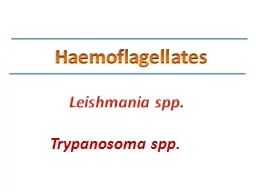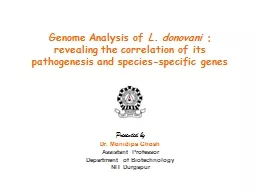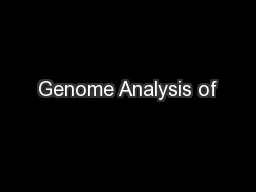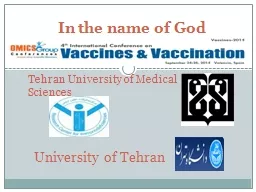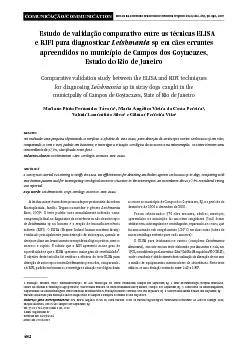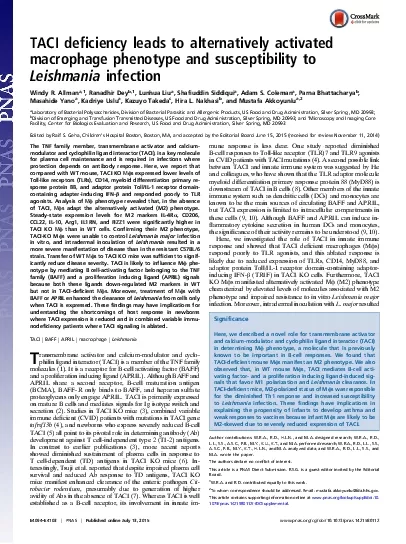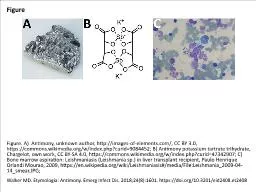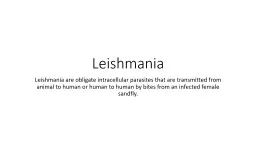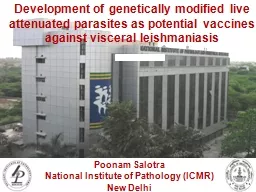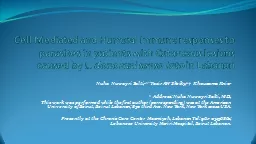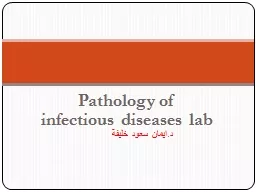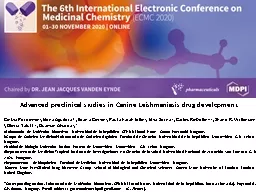PPT-Haemoflagellates Leishmania
Author : tabitha | Published Date : 2022-02-12
spp Trypanosoma spp Epimastigote Haemoflagellates of medical importance There are 4 parasitic stages or forms Amastigote amp Trypomastigote occur in vertebrate
Presentation Embed Code
Download Presentation
Download Presentation The PPT/PDF document "Haemoflagellates Leishmania" is the property of its rightful owner. Permission is granted to download and print the materials on this website for personal, non-commercial use only, and to display it on your personal computer provided you do not modify the materials and that you retain all copyright notices contained in the materials. By downloading content from our website, you accept the terms of this agreement.
Haemoflagellates Leishmania: Transcript
spp Trypanosoma spp Epimastigote Haemoflagellates of medical importance There are 4 parasitic stages or forms Amastigote amp Trypomastigote occur in vertebrate hosts Promastigote. Leishmanicidal Activity of . Meglumine Antimoniate (Glucantime). In . Promastigote. F. orms of . Leishmania . major. U. Barrie , Prof. M. Meneghetti , R. Omena , G. Melo. University at Albany, Federal University of Alagoas, . Leishmaniasis. . By. Tarik. . Zaher. ,MD. Assistant Professor of Endemic and Tropical Medicine ,. Zagazig. University. Background. Leishmaniasis. is a . protozoal. disease capable of causing a spectrum of clinical syndromes ranging from . L. . donovani. . : revealing the correlation of its pathogenesis and species-specific genes. . Presented by. Dr. . . Monidipa. . Ghosh. Assistant Professor. Department of Biotechnology. NIT Durgapur. L. . donovani. . : revealing the correlation of its pathogenesis and species-specific genes. . Presented by. Dr. . . Monidipa. . Ghosh. Assistant Professor. Department of Biotechnology. NIT Durgapur. In the name of God. . . Primary effects of new . leishmania. major antigen. on . Balb. /c mice Spleen.. Latifynia. A.*¹, ² . Gharagozlou. M ³, . Khamesipour. A4, Mir . Amin. . Mohammadi. A 4 ,. 482 COMUNICAÇÃO/COMMUNICATION 1. Fundação Estadual Norte Fluminense/Parque de Alta Tecnologia do Norte Fluminense, Campos dos Goytacazes, RJ. 2. Setor de Parasitologia, Hospital Veteriná SIAppendixFigS7BAmongthegenesassociatedwithM2phenotypeccl22andil10washigherinTACIKOBMDMsbutarg1il1rnandym1werecomparablebetweenthetwostrainsSIAppendixFigS7CThegeneforFIZZ1wasnotdetectedinBMDMfromeithe Walker MD. Etymologia: Antimony. Emerg Infect Dis. 2018;24(8):1601. https://doi.org/10.3201/eid2408.et2408. The promastigote stage (long, slender form with a free flagellum) is present in the saliva of infected sandflies. Human infection is initiated by the bite of an infected sandfly, which injects the promastigotes into the skin, where they lose their . Poonam. . Salotra. National Institute of Pathology (ICMR). New Delhi. Post Kala-azar Dermal . Leishmaniasis.. Impact of . Visceral . Leishmaniasis. VL Fact sheet. 200 Million People currently at risk for contracting VL. L. . donovani. . senso. . lato. . in Lebanon . . Nuha . Nuwayri. . Salti,. a. #*. . Yasir. AW . Skeiky,. b. †. . . Khouzama. . Knio. c. . #. . Address: Nuha . Nuwayri. . Salti. , MD.,. د.ايمان سعود خليفة. Types ( patterns ) of inflammatory response to infection:. 1- . Suppurative. inflammation.. 2- . Granulomatous. inflammation.. 3- . Cytopathic. /. cytoproliferative. .. Cintya Perdomo . a. , Elena Aguilera . b. , Ileana Corvo. a. , Paula . Faral. -Tello . c. , Elva Serna . d. , Carlos . Robello. . c, e. , . Shane. R. . Wilkinson. f. , Gloria Yaluff . d. , . Guzmán . Leishmania. . spp. from culture . Visceral . Leishmaniasis. . section . through spleen tissue. I. nfection . by . Leishmania. .. Phlebtomus. .. Diagram of Life cycle of . Leishmania. Life cycle of Leishmania spp..
Download Document
Here is the link to download the presentation.
"Haemoflagellates Leishmania"The content belongs to its owner. You may download and print it for personal use, without modification, and keep all copyright notices. By downloading, you agree to these terms.
Related Documents

